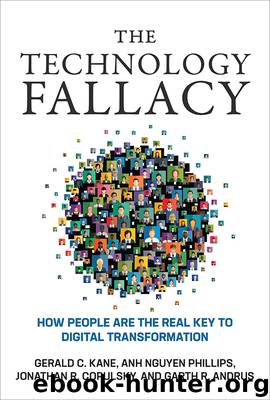The Technology Fallacy by Gerald C. Kane

Author:Gerald C. Kane
Language: eng
Format: epub
Tags: MIT Sloan Management Review; digital maturity; digital transformation; digital disruption; digital strategy; digital leadership; digital talent; business culture; business technology; workplace culture; future of work; Deloitte; digital DNA; Agile; Agile@Scale; collaboration; fail fast
Publisher: The MIT Press
Passive Recruiting Exacerbates the Talent Threat
The talent news gets even worse for less digitally mature companies. Not only are employees more likely to leave if they don’t obtain the opportunities to continue developing, but digitally maturing companies are also more likely to come get them. Less digitally mature organizations face an emerging practice known as passive recruiting, when companies search LinkedIn or other professional platforms to identify and approach individuals who have skills they desire, even though these people are not actively seeking to move. An executive we talked to notes: “The digital leaders that we bring in are not leaders that typically are looking for us. We’re typically looking for individuals that come with scale that have likely worked—and this is at the leadership level in particular—they’ve likely worked for companies that are larger than us, that are global. They are used to degrees of complexity and … can roll up their sleeves and sort of make things happen.”
Digital platforms enable this passive recruiting trend. Indeed, 75 percent of respondents from companies at all levels of the maturity spectrum reported that digital platforms had raised their profiles outside the organization. Over 50 percent of respondents had been approached unsolicited via these platforms by companies offering intriguing job opportunities. You can assume that the employees approached in this way will represent the more valuable half of your organization, not the less valuable or less productive employees.
Figure 9.5 graphically represents the recruiting advantage that digitally maturing companies possess. We tested two statements with survey respondents: (1) My organization’s embrace of digital business attracts new talent; and (2) my organization needs new talent to compete in the digital economy. Note that the intersection between the two lines in figure 9.5 is above the developing category. This result suggests that even developing companies are at risk of their best talent fleeing to digitally maturing companies. Forewarned is forearmed. Digitally maturing companies know that they possess an advantage in recruiting, and they are coming after your most valuable employees.
Figure 9.5
Download
This site does not store any files on its server. We only index and link to content provided by other sites. Please contact the content providers to delete copyright contents if any and email us, we'll remove relevant links or contents immediately.
| Ethics | Etiquette |
| Fashion & Image | Health & Stress |
| Motivation & Self-Improvement | Work Life Balance |
| Workplace Culture |
Tools of Titans by Timothy Ferriss(8226)
Change Your Questions, Change Your Life by Marilee Adams(7640)
Deep Work by Cal Newport(6890)
Playing to Win_ How Strategy Really Works by A.G. Lafley & Roger L. Martin(5939)
Man-made Catastrophes and Risk Information Concealment by Dmitry Chernov & Didier Sornette(5926)
Digital Minimalism by Cal Newport;(5669)
Big Magic: Creative Living Beyond Fear by Elizabeth Gilbert(5617)
The Slight Edge by Jeff Olson(5355)
Ego Is the Enemy by Ryan Holiday(5297)
The Motivation Myth by Jeff Haden(5158)
Stone's Rules by Roger Stone(5028)
The Laws of Human Nature by Robert Greene(5006)
Tuesdays with Morrie by Mitch Albom(4696)
Eat That Frog! by Brian Tracy(4440)
Rising Strong by Brene Brown(4382)
Skin in the Game by Nassim Nicholas Taleb(4165)
Bullshit Jobs by David Graeber(4101)
The Money Culture by Michael Lewis(4083)
Skin in the Game: Hidden Asymmetries in Daily Life by Nassim Nicholas Taleb(3935)
